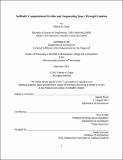Softbuilt : computational textiles and augmenting space through emotion
Author(s)
Davis, Felecia
DownloadFull printable version (10.21Mb)
Alternative title
Computational textiles and augmenting space through emotion
Other Contributors
Massachusetts Institute of Technology. Department of Architecture.
Advisor
Terry Knight.
Terms of use
Metadata
Show full item recordAbstract
When we inhabit, wear, and make textiles we are in conversation with our pre-historical and historical past and in a sense already connected to what is to come by the structure of fabric that operates as a mode of understanding the world. Textiles bind us together as a species in every culture on the planet, though we humans may use and make this material in different ways. In architecture, textiles made of animal skins or plant fibres were probably used to make the first shelters, as both protective clothing and enclosing space. As a liminal space between the body and environment these textiles became places of exchange and communication of information between people and their communities through shelter and clothing. This communication is an expression of personality and mood which makes an impression on those who would look upon the shelter or clothing. This communication is directly related to the expression of the material. The hypothesis of this dissertation is that textiles communicate emotion through material expression via vision and touch. Furthermore, computation augments what designers can communicate about emotion to people by the evocative power of transforming textile expressions. I present four experiments in this dissertation that explore the emotional and expressive attributes of computational textiles - textiles that respond to their environment via programming and sensors. Two experiments begin to define computational textiles through the acts of making the textiles. Two experiments with architectural textile panels begin to look at emotions communicated to people through vision and touch using computational textiles. Softbuilt refers to things and places made using methods that connect computational material expression, space and emotion. The contributions of the dissertation are the framework, Softbuilt, for understanding what computational textiles are, methods of fabrication for computational textiles, and an understanding of emotions communicated to people from computational textile expression.
Description
Thesis: Ph. D. in the field of Architecture: Design and Computation, Massachusetts Institute of Technology, Department of Architecture, 2017. Cataloged from PDF version of thesis. Includes bibliographical references (pages 270-284).
Date issued
2017Department
Massachusetts Institute of Technology. Department of ArchitecturePublisher
Massachusetts Institute of Technology
Keywords
Architecture.